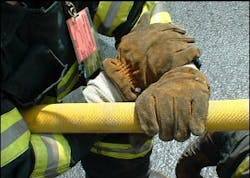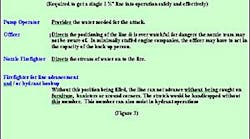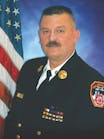The "Fire Stream Triangle" shows the three major elements required for an effective fire stream to effect the knock down of a fire.
For the handline stretch to be effective, it must deliver enough water to effect extinguishment and do so in a way that maintains safety. To accomplish this, there are three major elements for a fire stream to be considered effective. The "Fire Stream Triangle" shows the three major elements required for an effective fire stream (see Figure 1).
For any handline attack on a fire, all three legs of the triangle must be considered. Failure to do so will lead to injury, additional property loss, or a failure to stabilize the incident.
The three legs of the Fire Stream Triangle are:
- Manageable Nozzle Reaction
- Sufficient Flow
- Effective Reach
For simplicity, we will limit our discussion to those streams delivered from handlines using water as the primary extinguishing agent.
Manageable Nozzle Reaction
Nozzle reaction can best be described as resistance, measured in pounds of force, which a nozzle team must safely control in order to apply a stream of water. The amount of nozzle reaction is dependent upon the amount of water flowing and the nozzle pressure with which the water exits.
Too much nozzle reaction can lead to an unsafe situation. The only way for a nozzle operator to rectify this during a fire is to gate down the nozzle and reduce the amount of water flowing. While this will prevent the firefighter from losing control of the handline, it has the negative effect of reducing needed flow. While nozzle pressure is important to project the flow, it is this flow that is the key to extinguishment.
We must flow the most amount of water with the least amount of nozzle reaction and project this stream far enough to accomplish our mission.
Many fire departments have two choices of handlines for use in structural firefighting, 1 3/4-inch and 2 1/2-inch handlines. The use of one choice over the other is relative to the potential amount of water needed.
Any effective handline stretch requires multiple firefighters. The positioning on the line varies with the situation, but as a minimum, the working end of the line requires a nozzle team of no less than two members for efficiency and safety. The firefighter assigned to the nozzle controls flow while the backup firefighter absorbs the bulk of the nozzle reaction and also assists in the advance of the line. A nozzle team of two members can control around 70 to 80 pounds of reaction force under realistic interior conditions using standard techniques of holding the line with their hands, under their arms, clamping down on the line, and pushing forward.
Figures 2, 3, and 4 show selected flows and nozzle reactions. A good rule of thumb is any nozzle reaction of 70 to 80 pounds is adequately handled by two firefighters for short durations. Greater flows or longer durations require an additional member for safety or other techniques for controlling the reaction (Figure 5).
The 2 1/2-inch attack line can flow well over 300 gallons per minute (gpm), but the limitation lies with the number of personnel available to safely work the line and the techniques they use. Nozzle teams of three firefighters can safely support nozzle reactions of about 125 pounds of force using traditional methods just described.
Remember, a 2 1/2-inch handline is used because more water is needed. Safety can be compromised if the higher nozzle reaction is not taken into account. Improperly manned and without regard for higher nozzle reactions, we expose ourselves to danger.
Conclusion
Nozzle reaction should be a primary factor for determining what flows are needed by the department. A good requirement is each engine company be able to put one 1 3/4-inch attack line in operation effectively and do so with a flow rate of 150 gallons per minute or greater. As a minimum, two firefighters must be available to make up the nozzle team in addition to the other firefighters needed to advance the line and pump the apparatus. The company officer may have to double as the back-up member in lesser staffed companies.
One note about this article, it is not a rehash of the fog verse smoothbore nozzle debate. It simply emphasizes that higher flows at relatively lower nozzle reactions is safer and more efficient.
The second part of this series continues with our study of effective fire streams. Part 2 goes into some depth regarding effective reach, needed fire flow, and the need for adequate staffing.
References
- Fornell, David P. Fire Stream Management Handbook. Published by PennWell Publishing Company, 1991.
- For additional techniques for controlling nozzle reaction, as well as a host of other water supply topics, the reader should take a look at Layin' The Big Lines by Paul Shapiro
ARMAND F. GUZZI, Jr. has been a member of the fire service since 1987 and is a career firefighter with the Fire Department of the City of Long Branch, NJ. Armand is also an instructor with the Monmouth County, NJ, Fire Academy and he has a master's degree in management and has undergraduate degrees in fire science, education, and business administration. You can reach Armand by e-mail [email protected].

Armand Guzzi | Firehouse.com Contributor
Armand F. Guzzi, Jr. has been a member of the fire service since 1987. He recently retired a career fire lieutenant with the City of Long Branch, NJ, Fire Department and is the deputy director of the Monmouth County, NJ, Fire Academy where he has taught for over 20 years. He has a Master's degree in management and undergraduate degrees in fire science, education, and business administration. View all of Armand's articles here. He can be reached via e-mail at [email protected] or [email protected].







